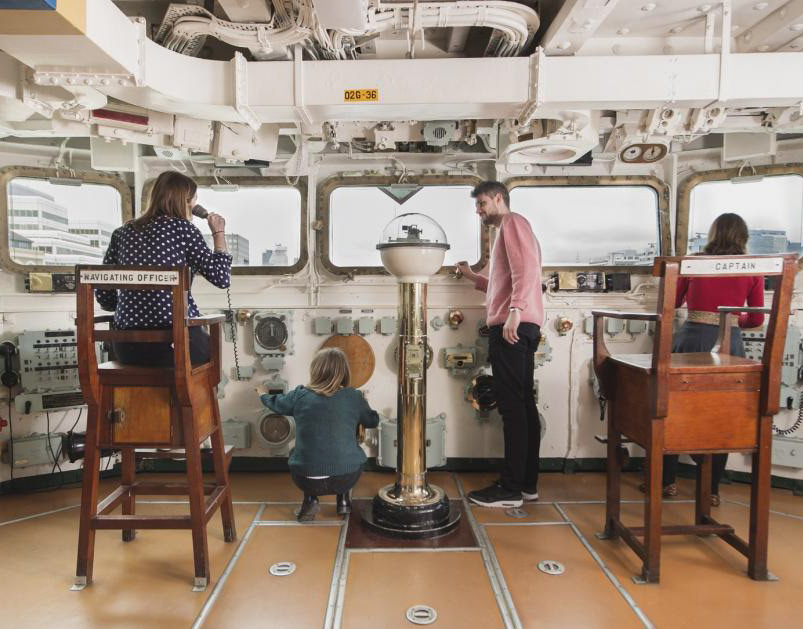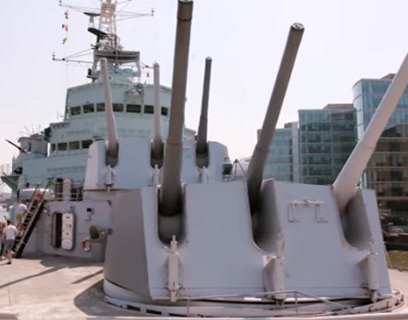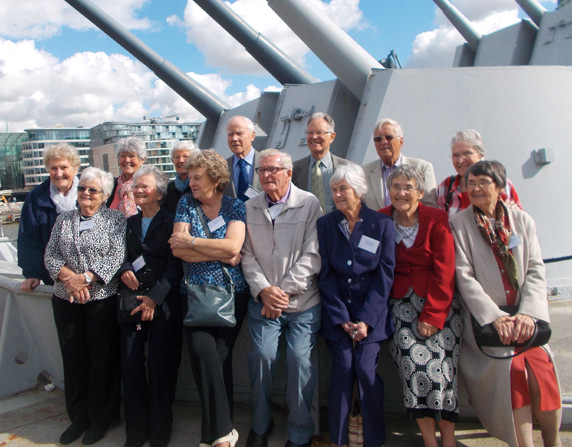The Ships Keel was laid at the Shipyard of Harland and Wolfe in Belfast on 21st September 1936. It was Launched by Anne Chamberlain wife of the Prime Minister on St Patrick's Day 17th March 1938. After fitting out and builders trials it was Commissioned into the Royal Navy on the 5th August 1939 under the command of Captain G A Scott DSO RN.
The cost of the ship was £2,141,514 which included £75,000 for the 6 inch Guns and £66,500 for the two Aircraft.
On the outbreak of war with Germany in September 1939 HMS Belfast formed part of the Cruiser Squadron operating out of the home fleet base at Scapa Flow. Over the next few weeks the ship was on constant patrol in Northern waters in the effort to impose a Blockade on Germany, on the 9th October she successfully intercepted the German Liner SS Cap Norte, the liner was boarded and sent under armed guard to a British port, this success was short-lived as just before noon on 21st November whilst leaving the Firth of Forth for a gunnery exercise the ship was rocked by a violent detonation of a magnetic mine, although casualty's were light the ships back was broken and it was at first thought the ship would have to be scrapped, but it was decided to repair her and it took almost three years before she could be made fit for action.
In November 1942 under the command of Captain Parham, HMS Belfast was the Largest and most powerful Cruiser in the Royal Navy.
Not only had she been bulged amidships she had also been equipped with the most up-to-date radar and fire control systems, she was assigned as Flagship of the 10th Cruiser Squadron wearing the flag of Rear Admiral Robert Burnett providing close range heavy cover for the Russian Convoys, during one of the convoys in the early morning of December 26th 1943 she encountered the Scharnhorst on her Radar, she was instrumental in helping to sink the Scharnhorst, this Battle was known as the battle of North Cape. for his part in the battle Rear Admiral Burnett was promoted to Vice Admiral and was created a Knight Commander of the Order of the British Empire.
After the completion of the Russian convoys Belfast was assigned to operation Neptune the Naval bombardment operation in support of the D-Day Normandy landing called operation Overlord, and as Flag ship of Bombarding force E was accredited with being the first bombarding ship to open fire on the British Beaches Juno & Sword, she was also accredited with getting closer to the shore than any other bombarding ship. She stayed on this bombarding station for five weeks until the troops were so far inland that her guns could no longer help the invading forces. she then returned to Plymouth for a well earned rest. She had fired her guns for the last time in anger in European waters.
She was then dispatched to the Far East in order to join the fleet fighting the Japanese, She arrived in the Far East in August 1945 just after the atomic Bombs had been dropped on Hiroshima and Nagasaki and Japan had surrendered. She still managed to do sterling work in helping to evacuate the emaciated survivors of the Japanese Prisoners of war and Civilian Internment camps, In October 1945 the Officers and Men organised a party for the children in the camps, the most popular item on the menu was chocolate which most of the children had never tasted before, the men even searched their lockers and every last piece of chocolate was consumed.
The Belfast continued on peacekeeping duties until the Autumn of 1947 when she returned home for a well earned rest and refit.
She returned to the Far East in December 1948 as Flag ship of the 5th Cruiser Squadron and although she was not involved in the HMS Amethyst incident in April 1949 she was the Flag Ship of the C in C Far East Admiral Sir Patrick Bond and all orders given to the Amethyst emanated from the Belfast.
The Belfast remained out in the Far East and in June 1950 when the Korean war broke out she was one of the first British units to go into action off the Korean Coast in support of the South Korean and Allied Armies, her main duties were patrolling and shore bombardment, she was well respected for her accurate gunnery and became known as that straight shooting ship. she took part in an Action that became known as the Battle of Changi-Do an important strategic Island off the Coast of Korea, which was captured during the night of 15th July 1952.
Belfast sailed for home on the 27th September 1952 she had spent 404 days on active service in the Korean War, her service was as long and arduous as her service with the home fleet during the second World War, as the Icy Conditions were often similar to those in the Arctic.
She returned to Britain and HMS Belfast's last years at sea were perhaps the happiest in her long eventful career For the ships company there was ample opportunities for relaxation between peacetime exercises as well as a round of official visits to some of the worlds most exotic ports. In August 1963 after a final exercise in the Mediterranean, she was paid off into reserve and reclassified as a Harbour accommodation Ship.
In May 1971 after 32 years of service during which she had steamed over half a million miles she was destined for the scrap yard, but help was at hand, as early as 1967 the Imperial War Museum had been looking into preserving a second world war Cruiser but the Government was not prepared to provide the Funding, But a Trust was formed by one of HMS Belfast former Captains, now Rear Admiral Sir Morgan Morgan-Giles. who succeeded in bringing her to London where she opened up to visitors on Trafalgar Day 21st October 1971.
The HMS Belfast Association was formed in 1998 from ex Crew Members.
To read "HMS BELFAST: a Battle-honoured Ship" click here





